|
|
|
Sort Order |
|
|
|
Items / Page
|
|
|
|
|
|
|
| Srl | Item |
| 1 |
ID:
091552


|
|
|
|
|
| Publication |
2009.
|
| Summary/Abstract |
In the context of emission markets, failure to include early action (EA) as a criterion when sharing out the reduction effort may be unfair. This paper presents (1) a method based on index decomposition that seeks to quantify EA and (2) a method for determining effort sharing considering EA. It is shown that, in the case of European industry (EU-15) and for the period 1995-2005, EA accounted for a reduction of 21% in energy-related CO2 emissions. Considering two alternative schemes for sharing out the reduction effort in European industry, equal shares (all industries in all countries reduce their emissions by the same percentage) and taking EA into account, we find that Spain, Austria, Italy, the United Kingdom and Sweden would be better off under an equal shares scheme as opposed to one that takes EA into account. The efforts of the remaining countries would be greater than if EA was taken into account. An equal shares scheme would also greatly benefit the textile, non-metallic mineral, paper and "other" industries, and would be particularly detrimental to the chemical, non-ferrous and other metal, and engineering industries.
|
|
|
|
|
|
|
|
|
|
|
|
|
|
|
|
| 2 |
ID:
099274
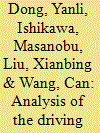

|
|
|
|
|
| Publication |
2010.
|
| Summary/Abstract |
By using the latest China-Japan input-output data sets and the index decomposition analysis (IDA) approach, this article analyzes the driving forces of CO2 emissions embodied in trade between the two countries during 1990-2000. We found that the growth of trade volume had a large influence on the increase of CO2 emissions embodiments in bilateral trade. The dramatic decline in carbon intensity of the Chinese economy is a primary cause in offsetting CO2 emissions exported from China to Japan over 1995-2000. We argue that a better understanding of the factors affecting CO2 emissions embodied in international trade will assist in seeking more effective climate policies with wider participation in the post-Kyoto regime.
|
|
|
|
|
|
|
|
|
|
|
|
|
|
|
|
| 3 |
ID:
150792


|
|
|
|
|
| Summary/Abstract |
A large number of studies have been conducted on the contribution of technological progress and structural change to the evolution of aggregate energy intensity in the industrial sector. However, no analyses have been done to examine theses changes in the non-energy intensive industry in France. We analyzed their importance in French industry with respect to their energy intensity, energy costs, value added, labour and the diffusion of production sites by using data at the 3-digit level with 236 sectors. Using a new decomposition method that gives no residual, this paper attempted to examine, over 10 years from 1996 to 2005, the changes that occurred in an area that has been neglected in energy analysis. We found that structural change had an overwhelming effect on the decline of aggregate energy intensity. Furthermore, we found that the higher the level of sector disaggregation, the more significant the changes that can be attributed to structural change, due to the homogeneity of this industrial group. The results of our study show that it is important to take into account the effects of structural change in “bottom-up” modelling exercises so as to improve the accuracy of energy demand forecasting for policy-makers and scientists.
|
|
|
|
|
|
|
|
|
|
|
|
|
|
|
|
| 4 |
ID:
150669
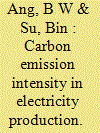

|
|
|
|
|
| Summary/Abstract |
We study changes in the aggregate carbon intensity (ACI) for electricity at the global and country levels. The ACI is defined as the energy-related CO2 emissions in electricity production divided by the electricity produced. It is a performance indicator since a decrease in its value is a desirable outcome from the environmental and climate change viewpoints. From 1990 to 2013, the ACI computed at the global level decreased only marginally. However, fairly substantial decreases were observed in many countries. This apparent anomaly arises from a geographical shift in global electricity production with countries having a high ACI increasingly taking up a larger electricity production share. It is found that globally and in most major electricity producing countries, reduction in their ACI was due mainly to improvements in the thermal efficiency of electricity generation rather than to fuel switching. Estimates of the above-mentioned effects are made using LMDI decomposition analysis. Our study reveals several challenges in reducing global CO2 emissions from the electricity production sector although technically the reduction potential for the sector is known to be great.
|
|
|
|
|
|
|
|
|
|
|
|
|
|
|
|
| 5 |
ID:
149885
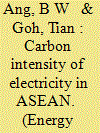

|
|
|
|
|
| Summary/Abstract |
The Association of Southeast Asian Nations (ASEAN), with its ten member countries, has a total population exceeding 600 million. Its energy-related CO2 emissions have been growing and in 2013 amounted to 3.6% of total global emissions. About 40% of ASEAN's energy-related CO2 emissions are currently attributable to electricity production. In view of this high share, we study the CO2 emissions of ASEAN's electricity production sector with a focus on the aggregate emission intensity (ACI) given by the level of CO2 emissions for each unit of electricity produced. Drivers of ACI are analysed for individual countries and spatial analysis is conducted by comparing factors contributing to differences between the ACIs of individual countries and that of the ASEAN average. Arising from these analyses and in light of the current developments, it is concluded that drastic actions need to be taken both at the national and regional levels in order to reduce growth in the region's electricity-related CO2 emissions. Two key policy issues, namely overcoming national circumstances to improve electricity generation mix and improving power generation efficiency, are further discussed.
|
|
|
|
|
|
|
|
|
|
|
|
|
|
|
|
| 6 |
ID:
121290
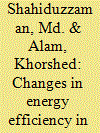

|
|
|
|
|
| Publication |
2013.
|
| Summary/Abstract |
This paper provides an empirical estimation of energy efficiency and other proximate factors that explain energy intensity in Australia for the period 1978-2009. The analysis is performed by decomposing the changes in energy intensity by means of energy efficiency, fuel mix and structural changes using sectoral and sub-sectoral levels of data. The results show that the driving forces behind the decrease in energy intensity in Australia are efficiency effect and sectoral composition effect, where the former is found to be more prominent than the latter. Moreover, the favourable impact of the composition effect has slowed consistently in recent years. A perfect positive association characterizes the relationship between energy intensity and carbon intensity in Australia. The decomposition results indicate that Australia needs to improve energy efficiency further to reduce energy intensity and carbon emissions.
|
|
|
|
|
|
|
|
|
|
|
|
|
|
|
|
| 7 |
ID:
125634
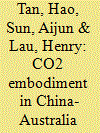

|
|
|
|
|
| Publication |
2013.
|
| Summary/Abstract |
This study focuses on CO2 emissions 'embodied' in the characteristic China-Australia bilateral trade, which refer to the CO2 emissions due to the production of goods traded between the two countries. We perform an assessment of the CO2 embodiment in the trade during the period between 2002 and 2010. We find that the scale effect has been a dominant effect contributing to an increase of CO2 emissions embodied in the bilateral trade through the years; while the composition effect seems to be a major driver for reducing CO2 embodiment in the exports of Australia to China. Based on an analysis of the difference between the amounts of actual CO2 embodiment and those in a hypothetical 'no-trade' scenario, we estimate that the 'net' CO2 emissions due to the bilateral trade declined from around 10 Mt of CO2 emissions in 2002 to -10 Mt in 2010; that is, the bilateral trade contributed to a reduction of the global carbon emissions in the recent years. This finding suggests that the rapid growth of exports of carbon-intensive goods from Australia to China has helped in reducing carbon emissions globally because carbon intensity factors of those goods are much lower in Australia than those in China.
|
|
|
|
|
|
|
|
|
|
|
|
|
|
|
|
| 8 |
ID:
115668


|
|
|
|
|
| Publication |
2012.
|
| Summary/Abstract |
Index decomposition analysis based on economic output is frequently employed to provide an indication of energy intensity trends in industry. Additionally, composite energy efficiency indicators, calculated using physical output, are used to give a more accurate view of energy efficiency progress. Both approaches are commonly presented in one study but often with a different mathematical basis for each. This may lead to inconsistent results. We demonstrate using practical case studies that when all physical and economic output data are available for industry sub-sectors, these can be combined in a single decomposition analysis that provides an energy efficiency indicator based on physical production and an indicator of the influence of structural change based on value added. Using the same methodology for both results ensures that the results are consistent and provides insights into the effects of changing prices of goods on aggregate energy intensity. In the case studies examined, falling unit values of industrial goods produced over time tend to increase the energy intensity of industry.
|
|
|
|
|
|
|
|
|
|
|
|
|
|
|
|
| 9 |
ID:
125751


|
|
|
|
|
| Publication |
2013.
|
| Summary/Abstract |
In Austria a considerable number of measures have been implemented to reduce final energy use for residential heating since the 1990s. The aim of this analysis is to investigate, why - despite these implemented measures - final energy use for heating has not decreased in the expected way. The impact of eight factors on final energy use for heating is quantified by applying the Logarithmic Mean Divisia Index (LMDI I) method. The dataset covers the sector of private households in Austria for the period from 1993 to 2009. The main findings of the analysis are: (1) while technical improvements reduce final energy use for heating significantly, rising comfort needs nearly outweigh these savings. (2) Consumer behaviour reduces calculated final energy use considerably. (3) The extent of this reduction is declining significantly in the period observed. (4) The growing share of single-family houses has increased energy demand for heating in the observed period, though a reversal of this trend is detected from 2007 onwards. (5) The impact of growing floor space per person is the major effect revealed by the analysis. (6) Weather conditions have a major impact on annual fluctuations of energy consumption.
|
|
|
|
|
|
|
|
|
|
|
|
|
|
|
|
| 10 |
ID:
180106
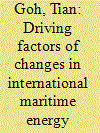

|
|
|
|
|
| Summary/Abstract |
Emissions have been a critical concern for the shipping sector, calling for climate mitigation measures to be implemented in this field urgently. It is therefore useful to understand the factors that influence the relevant empirical trends so that policies can be better tailored to address the climate challenges. Given the high reliance on fossil fuels, this paper has focused on the energy consumption from international shipping, by examining 6 factors across product types and shipping routes. This is based on comprehensive microdata of almost all vessels in the world over 2014–2017. The study finds that improvements in energy intensity is consistent across product types and shipping routes, reinforcing the importance of energy efficiency as a key climate mitigation measure. However, shifts in freight transport activity across different regions have offset gains in energy efficiency and was the most dominant factor contributing to an increase in energy consumption. Monitoring of the transport structure effect is critical for progress tracking and the potential of this effect to alter energy consumption should also be factored into emission projections.
|
|
|
|
|
|
|
|
|
|
|
|
|
|
|
|
| 11 |
ID:
096648
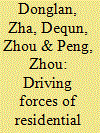

|
|
|
|
|
| Publication |
2010.
|
| Summary/Abstract |
There exist many differences between urban and rural China among which residential CO2 emissions arising from energy consumption is a major one. In this paper, we estimate and compare the energy related CO2 emissions from urban and rural residential energy consumption from 1991 to 2004. The logarithmic mean Divisia index decomposition analysis is then applied to investigate the factors that may affect the changes of the CO2 emissions. It is found that energy intensity and the income effects, respectively, contributed most to the decline and the increase of residential CO2 emissions for both urban and rural China. In urban China, the population effect was found to contribute to the increase of residential CO2 emissions with a rising tendency. However, in rural China, the population effect for residential CO2 emissions kept decreasing since 1998.
|
|
|
|
|
|
|
|
|
|
|
|
|
|
|
|
| 12 |
ID:
097481
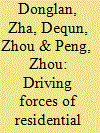

|
|
|
|
|
| Publication |
2010.
|
| Summary/Abstract |
There exist many differences between urban and rural China among which residential CO2 emissions arising from energy consumption is a major one. In this paper, we estimate and compare the energy related CO2 emissions from urban and rural residential energy consumption from 1991 to 2004. The logarithmic mean Divisia index decomposition analysis is then applied to investigate the factors that may affect the changes of the CO2 emissions. It is found that energy intensity and the income effects, respectively, contributed most to the decline and the increase of residential CO2 emissions for both urban and rural China. In urban China, the population effect was found to contribute to the increase of residential CO2 emissions with a rising tendency. However, in rural China, the population effect for residential CO2 emissions kept decreasing since 1998.
|
|
|
|
|
|
|
|
|
|
|
|
|
|
|
|
| 13 |
ID:
177373
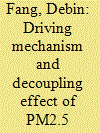

|
|
|
|
|
| Summary/Abstract |
Haze pollution has been a serious environmental issue in China, however, little research has focused on the industrial sector which accounts for a large part of total PM2.5 emissions. This paper aims to disclose the driving mechanism and decoupling effect of industrial PM2.5 emissions. First, this study reveals the spatial-temporal drivers of industrial PM2.5 emissions in China spanning 2000–2014 through geographical detector and logarithmic mean Divisia index decomposition, respectively. Then, the decoupling causal chain of industrial economic growth and PM2.5 emissions is investigated by a refined Laspeyres index method. The empirical results illustrate that: (1) Population distribution is the dominating factor for the spatial heterogeneity of industrial PM2.5 emissions. Different influencing factors show significant synergistic effects. (2) Industrial development effect is the main reason for the increase of industrial PM2.5 emissions, while the reduction in industrial PM2.5 emissions is primarily due to energy intensity effect, followed by coal pollution intensity and energy mix effects. (3) During the study period, the PM2.5-economic growth decoupling undergoes two states, and shows the tendency towards strong decoupling. (4) The PM2.5-coal consumption effect and energy consumption-economic growth effect are important factors influencing the changes of PM2.5-economic growth decoupling indicator, while the impact of the coal consumption-energy consumption effect is quite small. This paper provides important implications for reducing industrial PM2.5 emissions.
|
|
|
|
|
|
|
|
|
|
|
|
|
|
|
|
| 14 |
ID:
110425
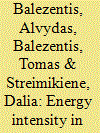

|
|
|
|
|
| Publication |
2011.
|
| Summary/Abstract |
The measurement, assessment, and effective mitigation of energy intensity compose a foremost objective of contemporary energy policy. Although the European Union (EU) Member States have been experiencing the convergence in energy efficiency indicators, Lithuania, acceded to the EU in 2004, still remains peculiar with relatively high energy intensity. Our study, therefore, is aimed at analyzing the energy intensity trends in Lithuanian economy as a whole as well as in separate economic sectors. The investigation covers the period of 1995-2009. The Logarithmic Mean Divisia Index was applied for decomposition analysis. Our analysis has shown that energy efficiency falls during economic downturn. In order to facilitate these challenges the Lithuanian Government as well as business should opt for increasing energy efficiency in the most problematic sectors of transport and services. In addition, the analysis of legal acts, namely National Energy Efficiency Programme for 2006-2010 and Energy Efficiency Action plan for 2010-2016, was taken into consideration. Some suggestions, thus, were offered for successful implementation of strategic goals outlined in the aforementioned strategic documents.
|
|
|
|
|
|
|
|
|
|
|
|
|
|
|
|
| 15 |
ID:
099292


|
|
|
|
|
| Publication |
2010.
|
| Summary/Abstract |
Several index decomposition methods are commonly employed to provide a top-down view of energy consumption trends in manufacturing industry. These approaches typically use value added data for an industrial sector to decompose energy trends into structural, intensity and activity effects. Additionally in Europe a commonly employed top-down indicator called ODEX uses units of physical output, rather than value added, to analyse energy efficiency developments only. Therefore it has been difficult to compare ODEX directly to decomposition approaches. This paper presents a new decomposition method called VALDEX, based on the existing ODEX methodology, but using value added data. Extending ODEX to a full decomposition method allows tests commonly used in index decomposition theory to be applied and enables direct comparison with other methods. This helps evaluate the robustness of the existing ODEX methodology. Using industry data from three European countries, the results yielded by five decomposition methods are compared. In the cases examined, both the Laspeyres and VALDEX methods have significant residuals. Laspeyres consistently overestimates total energy consumption while VALDEX underestimates it. Methods that produce small or no unexplained residuals give converging results for each effect for the countries analysed, and provide a more reliable view of energy trends.
|
|
|
|
|
|
|
|
|
|
|
|
|
|
|
|
| 16 |
ID:
177157
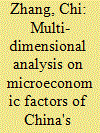

|
|
|
|
|
| Summary/Abstract |
Reducing energy intensity is the key point to solve the contradiction among economic development, energy constraints and environmental pressure in China. Considering microeconomic factors, this paper extends decomposition and attribution models, and analyses the drivers of China's industrial aggregate energy intensity (AEI) at the regional/sectoral level. The results show that AEI decreased by 49% during 2000–2017. At the regional level, most provinces presented negative contribution on regional energy intensity effect. The AEI decline was attributed to the drop of greatest negative effect of R&D efficiency in Liaoning. The increase in investment intensity and R&D intensity lead to an increase in AEI, largely owning to Shandong and Liaoning, respectively. At the sectoral level, the AEI decline can be mainly explained by the inhibition effect of energy intensity and R&D efficiency. However, this negative contribution was greatly offset by the R&D intensity effect. The investment intensity showed a positive impact in AEI increase, and smelting and pressing of ferrous metals sector was the main contributor. Regional and sectoral investment structure effect shifted from increasing to decreasing AEI over the study period. Based on the results, targeted policy recommendations are proposed to further decrease the China's industrial AEI in the 14th FYP period.
|
|
|
|
|
|
|
|
|
|
|
|
|
|
|
|
| 17 |
ID:
092775
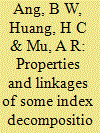

|
|
|
|
|
| Publication |
2009.
|
| Summary/Abstract |
We study the properties and linkages of some popular index decomposition analysis (IDA) methods in energy and carbon emission analyses. Specifically, we introduce a simple relationship between the arithmetic mean Divisia index (AMDI) method and the logarithmic mean Divisia index method I (LMDI I), and show that such a relationship can be extended to cover most IDA methods linked to the Divisia index. We also formalize the relationship between the Laspeyres index method and the Shapley value in the IDA context. Similarly, such a relationship can be extended to cover other IDA methods linked to the Laspeyres index through defining the characteristic function in the Shapley value. It is found that these properties and linkages apply to decomposition of changes conducted additively. Similar properties and linkages cannot be established in the multiplicative case. The implications of the findings on IDA studies are discussed.
|
|
|
|
|
|
|
|
|
|
|
|
|
|
|
|
| 18 |
ID:
176750
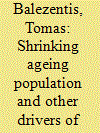

|
|
|
|
|
| Summary/Abstract |
Energy use and the resulting environmental impacts are interrelated with socioeconomic development of a certain region. What is more, the residential sector plays an important role as a major consumer of the energy. Thus, it is important to identify the underlying patterns of energy consumption and the resulting CO2 emission amidst the external shocks. This paper focuses on the case of residential energy consumption and CO2 emission in Lithuania over 2004–2016. This example is important given the context of shifts in the size and structure of population, economy and energy transformation in Lithuania that occurred over the period covered. The analysis relies on the index decomposition analysis and factorizes the changes in CO2 emission into the effects of population size, household size, dwelling area, energy intensity and carbon factor. The results indicate that decline in energy intensity and population played the most important role in pushing the CO2 emission down, yet these effects were offset by the changes in the lifestyle of the population (i.e. household size and dwelling area) along with increasing carbon factor. These findings are contrasted to the corresponding findings form the earlier studies around the world and the resulting policy implications are delivered.
|
|
|
|
|
|
|
|
|
|
|
|
|
|
|
|
| 19 |
ID:
166456
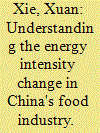

|
|
|
|
|
| Summary/Abstract |
Although China's food industry is not energy-intensive, its rapid development has brought enormous challenges to the realization of the energy-saving goal due to its huge scale. So the industry must reduce its energy intensity as much as possible. This paper uses a comprehensive decomposition analysis to study the energy intensity changes in China's food industry between 2000 and 2013, and draws the following conclusions: (1) technological progress have the most significant impact on reducing energy intensity, reducing it by 70.2%; (2) technical efficiency change hinders the energy intensity decline, which in turn increases it by 18.4%; (3) the substitution of capital for energy is conducive to the decline of energy intensity; (4) the government's industrial policy has played a role in energy conservation, but there is room for improvement. Therefore, this paper suggests that: Firstly, the R&D investment in production and management technology should continue to increase, and more importance should be attached to technology diffusion and transfer between regions. Secondly, more effective incentives and stricter constraints should be implemented for the food industry. Thirdly, the planning of the industry layout should be adapted to regional advantages, and targeted policies should be carried out in different regions.
|
|
|
|
|
|
|
|
|
|
|
|
|
|
|
|
|
|
|
|
|